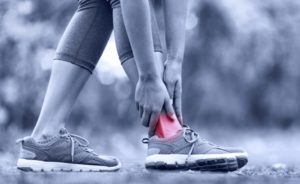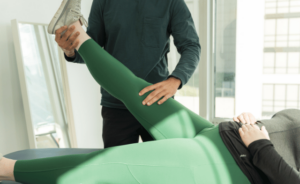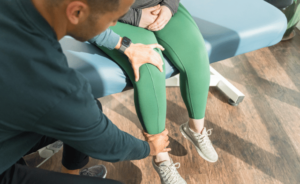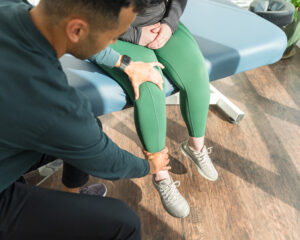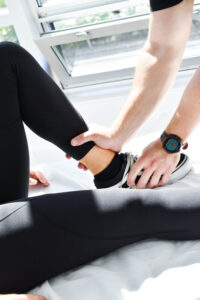At our downtown physiotherapy clinic, we leverage cutting-edge techniques such as Intramuscular Stimulation (IMS) and dry needling to help runners overcome these challenges and return to their favorite activity without pain. Our physiotherapists are committed to keeping you running smoothly along the seawalls of Stanley Park, the trails of the North Shore, and every path in between. Today, we want to share how one of our favourite physiotherapy treatments – IMS and dry needling – can be particularly beneficial for treating runner’s knee.
Understanding Runner’s Knee
What is Runner’s Knee?
Runner’s knee, medically known as patellofemoral pain syndrome (PFPS), is a condition characterized by pain around the front of the knee and the patella, or kneecap. It is commonly seen in individuals who participate in activities that require frequent knee bending — running, jogging, squatting, and cycling.
While commonly associated with athletes, runner’s knee can affect anyone regardless of athletic prowess. Factors such as misalignment of the kneecap, muscle imbalances, and inadequate stretching can contribute to its development.
Common Symptoms of Runner’s Knee
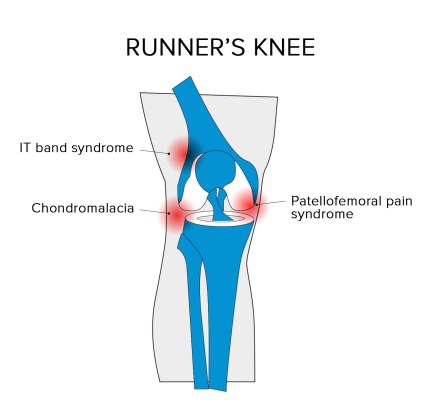
Runner’s knee can arise from overuse, direct trauma to the knee, misalignment of the kneecap, and weaknesses or imbalances in the thigh muscles. It is also influenced by other factors, such as flat feet or abnormal foot positioning. Regardless of the cause, the most common symptoms of runner’s knee include:
- Dull, aching pain around the front of the kneecap
- Pain during exercise or after prolonged sitting with knees bent
- Swelling around the knee
- A popping or grinding sensation in the knee
How Dry Needling Relieves Runner’s Knee
What is Dry Needling?
Before delving into how dry needling and IMS can relieve runner’s knee, it’s important to understand what dry needling and IMS are. Dry needling is a modern treatment designed to ease muscular pain. Performed by one of our physiotherapists, trained specifically in this technique, the premise of dry needling and IMS is to insert tiny filament needles into specific parts of the muscle tissue that are highly sensitive. These points of tight muscle fibers – known as trigger points – contribute to pain throughout the body, including the knee. The needle is used to stimulate the muscle and ultimately promote healing and recovery through a myriad of ways.
It Promotes Muscle Relaxation
Myofascial trigger points are hyperirritable spots in skeletal muscle that are associated with a hypersensitive palpable nodule in a taut band. Trigger point dry needling involves the insertion of a needle into these points to promote muscle relaxation and alleviate pain. The mechanical stimulus of the needle itself can lead to a local twitch response, which is a brief contraction of the taut muscle fibers, helping to deactivate the trigger point, restore normal muscle length, and reduce compressive stress on the patellofemoral joint.
It Enhances Blood Flow
The process of dry needling increases blood circulation to the affected areas. Enhanced blood flow to the affected knee area not only helps in reducing inflammation by removing pro-inflammatory mediators, but it also facilitates the delivery of oxygen and nutrients necessary for tissue repair. This improved local circulation can accelerate the healing process and contribute to the resolution of connective tissue dysfunction.
It Promotes Tissue Healing & Repair
By causing a minor controlled injury to the affected tissue, dry needling stimulates the body’s natural healing response. The procedure initiates a cascade of events that lead to the production of growth factors and activation of fibroblasts, which are crucial for the synthesis of new connective tissue. This reparative process helps in the restoration of impaired tissues and supports the normalization of the biomechanics of the knee joint.
It Modulates Pain
Dry needling has been shown to influence the way the central nervous system processes pain signals. The technique may stimulate the release of endogenous opioids, which are the body’s natural pain-relieving chemicals. It also can affect the dorsal horn of the spinal cord, which plays a key role in pain modulation. This dual mechanism can help reduce the perception of pain significantly, providing relief to individuals suffering from chronic knee pain.
How Dry Needling Works at Vancouver Physiotherapy Hub
At Vancouver Physiotherapy Hub, our approach to treating runner’s knee with dry needling is comprehensive and personalized. Here’s what you can expect in your treatment
Initial Assessment
Our skilled physiotherapists begin with a detailed assessment of your condition. This includes a review of your medical history, a physical examination, and an evaluation of your knee pain and mobility. This thorough understanding allows us to tailor the dry needling treatment specifically to your needs.
Treatment
Dry needling and IMS are components of a larger approach to sports injury and sports physiotherapy. Once suitability is confirmed, our physiotherapists perform dry needling. These needles are precisely inserted into specific trigger points that have been identified during the assessment. The treatment may be combined with other therapeutic interventions like manual therapy, exercises, or advice to maximize recovery and prevent future injuries.
During the session, our therapists carefully monitor your response to the treatment to ensure optimal placement and effect of the needles. Adjustments are made as needed, based on your feedback and our expertise.
Treatment Plan & Homecare
Post-treatment, we provide guidance on activities or exercises to continue at home, enhancing the benefits of the session. Our physiotherapists will also recommend a series of regular follow-ups to ensure that your recovery continues.
Success Stories
Case Study 1: The Marathon Runner
John, a 35-year-old marathon runner, presented with chronic knee pain that was diagnosed as runner’s knee. After four sessions of dry needling, combined with a tailored physiotherapy program, he reported a significant reduction in pain and improved knee function. John was able to resume his marathon training without discomfort.
Case Study 2: The Weekend Warrior
Emma, a 29-year-old recreational runner, suffered from persistent knee pain that made it difficult to participate in 5K runs, which she loved. After a series of dry needling sessions at our clinic, she experienced noticeable pain relief and was back to running her favorite trails.
Conclusion
At Vancouver Physiotherapy Hub, we are committed to helping our clients overcome injuries and return to their preferred activities as quickly as possible. Runner’s knee can be a debilitating condition, but with the right approach, including treatments like dry needling, relief is not only possible but achievable. Contact us today to learn how we can help you get back on track with less pain and more performance.
Our team of experts is here to guide you through each step of your recovery journey, ensuring you receive the personalized care you deserve. Ready to start your journey towards recovery? Reach out to Vancouver Physiotherapy Hub today!

